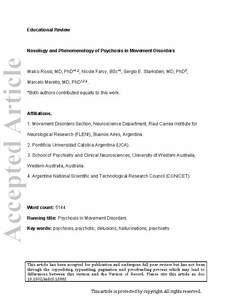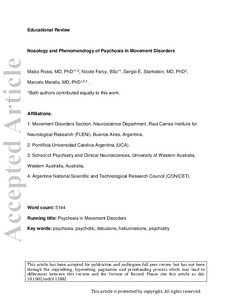Por favor, use este identificador para citar o enlazar este ítem:
https://repositorio.uca.edu.ar/handle/123456789/10123| Título: | Nosology and phenomenology of psychosis in movement disorders | Autor: | Rossi, Malco Damián Farcy, Nicole Starkstein, Sergio E. Merello, Marcelo |
Palabras clave: | TRASTORNOS DEL MOVIMIENTO; PSICOSIS; DELIRIO; ALUCINACIONES; PSIQUIATRIA | Fecha de publicación: | 2020 | Editorial: | Wiley | Cita: | Rossi, M. D. Nosology and phenomenology of psychosis in movement disorders [en línea]. Postprint del artículo publicado en Movement Disorders Clinical Practice. 2020, 7(2). doi:10.1002/mdc3.12882 Disponible en: https://repositorio.uca.edu.ar/handle/123456789/10123 | Resumen: | Background: Psychotic symptoms, such as delusions and hallucinations, are part of the clinical picture of several conditions presenting movement disorders. Phenomenology and epidemiology of psychosis in Parkinson's disease have received wide attention; however, the presence of psychosis in other movement disorders is, comparatively, less well known. Objectives: To review psychotic symptoms present in different movement disorders. Methods: A comprehensive and structured literature search was performed to identify and analyze data on patients with movement disorders and comorbid psychosis. Results: In monogenic parkinsonisms, such as PARK‐GBA, PARK‐LRRK2, and PARK‐SNCA, visual hallucinations related to dopamine replacement therapy are frequent as well as are delusions in PARK‐LRRK2 and PARK‐SNCA, but not in PARK‐GBA. Different types of delusions and hallucinations are found in Huntington's disease and other choreic disorders. In Tourette's syndrome, paranoid delusions as well as visual, olfactory, and auditory hallucinations have been described, which usually develop after an average of 10 years of disease. Delusions in ataxias are more frequent in ATX‐TBP, ATX‐ATN1, and ATX‐ATXN3, whereas it is rare in Friedreich's ataxia. Psychosis is also a prominent and frequent clinical feature in Fahr's disease, Wilson's disease, neurodegeneration with brain iron accumulation, and some lysosomal storage disorders, whereas it is uncommon in atypical parkinsonisms and dystonia. Psychosis usually occurs at late disease stages, but may appear as onset symptoms of the disease, especially in Wilson's disease, Huntington's disease, late‐onset Tays‐Sachs, and Niemann‐Pick. Conclusion: Psychosis is a frequent comorbidity in most hyper‐ and hypokinetic movement disorders. Appropriate recognition is relevant both in the early and late disease stages. | URI: | https://repositorio.uca.edu.ar/handle/123456789/10123 | ISSN: | 2330-1619 | Disciplina: | MEDICINA | DOI: | 10.1002/mdc3.12882 | Derechos: | Acceso abierto. 12 meses de embargo | Fuente: | Movement Disorders Clinical Practice. 2020, 7(2) |
| Aparece en las colecciones: | Artículos |
Ficheros en este ítem:
| Fichero | Descripción | Tamaño | Formato | |
|---|---|---|---|---|
| nososology-phenomenology-psychosis-movement.jpg | 160,29 kB | JPEG |  Visualizar/Abrir | |
| nososology-phenomenology-psychosis-movement.pdf | 295,28 kB | Adobe PDF |  Visualizar/Abrir |
Visualizaciones de página(s)
269
comprobado en 24-dic-2025
Descarga(s)
324
comprobado en 24-dic-2025
Google ScholarTM
Ver en Google Scholar
Altmetric
Altmetric
Este ítem está sujeto a una Licencia Creative Commons

